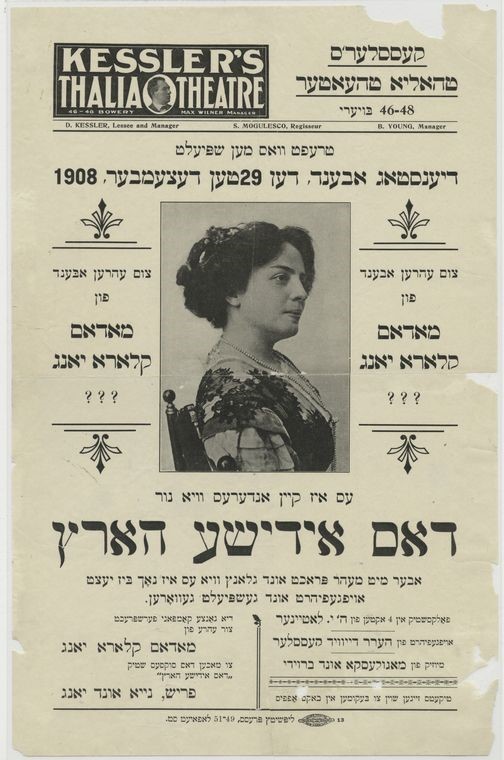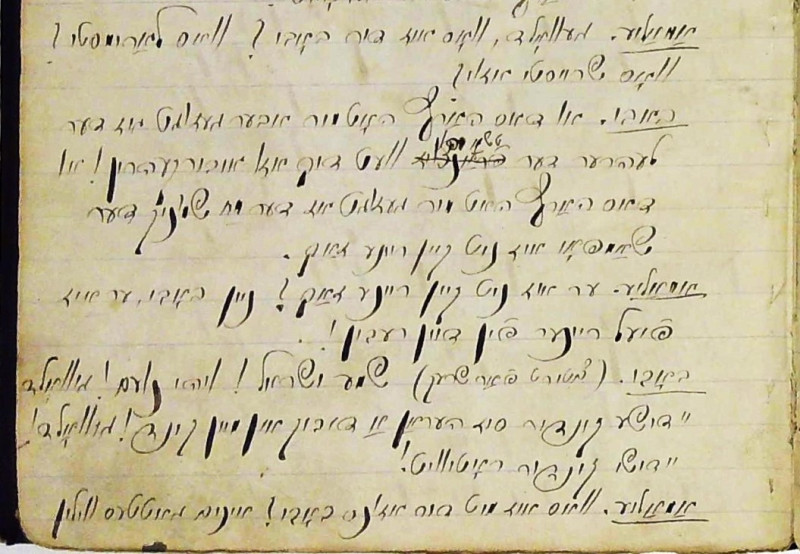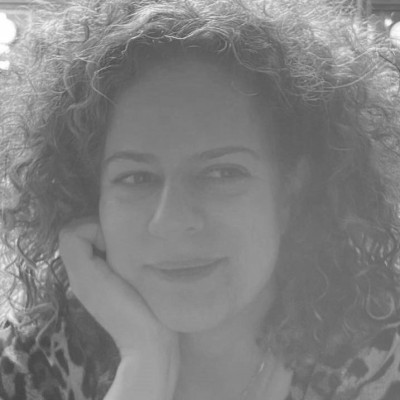Performance As Knowledge: The Datafication of Yiddish Popular Theatre
Ruthie Abeliovich, 10 October 2023
What can old Yiddish prompting notebooks, popular theatre ephemera and sound recordings teach us about our culture? The Yiddish theatre was a popular cultural arena for Jews in Europe and the US at the turn of the 20th century. Catering to its audiences’ craving for amusement, the Yiddish theatre produced a staggering bulk of entertainment. Most of its crowd-pleasing output was, however, delegitimized by Jewish intellectuals, journalists, and scholars, who considered it as Shund (literally, ‘trash’) – a primitive, plagiarized, vulgar, banal, and worthless form of art. In the aftermath of the marginalization of Shund, a valuable component of the cultural experience of the Jewish diaspora in modern times – and, by extension, of the twentieth-century mainstream culture – has largely been overlooked. Yiddish popular theatre played a pivotal role in transporting cultural styles, ideas and commodities at times of massive migration movements in Europe and beyond; its theatrical practices and embodied modes of expression left their mark on popular show business as we know it today.
In order to understand the complexity and scope of Yiddish popular theatre and to examine the cultural knowledge embedded in it, we launched the DYBBUK project in 2021: a five-year large scale research project, based at the Yolanda and David Katz Faculty of the Arts at Tel Aviv University and funded by the European Research Council (ERC).1 The multidisciplinary project team comprises Yiddishists, theatre scholars, musicians, musicologists and digital humanities experts, who join hands to decipher, record and analyze the dramatic themes, theatrical forms and performance practices of the Yiddish popular theatre in Europe and the United States, between 1880 and 1920 – from the emergence of professional Yiddish theatre, to the end of the Great War. Together we study the performative and cultural knowledge inscribed into the Yiddish popular theatre.
We began our endeavor with extensive archival diggings in Europe and the US, gleaning data, and subsequently created a digital database that would aptly map and display the dramatic and musical oeuvre and theatrical activities of Yiddish theatre playwrights and composers, actors, and prompters, as well as performances, theatre ephemera, and sound recordings. We collected anything and everything: scripts and scores, newspaper ads, posters, sound recordings and songs. These materials enabled us to differentiate the material archival objects, which relate to, however remain different from their stage production; within this scheme, the theatrical representation was addressed as an abstract repeatable iteration, manifested through its remains. Each performance has several iterations, which can be partially accessed by attending to its vestiges.

To gain a clear perspective not only on our field of study, but also on the scholarship and criticism that it yielded, we collected and transcribed references for all the miscellaneous details – alighting on contradictions, mistakes, and mix-ups within our data. How is this possible? Because our database is not about truth, but about the production of knowledge, and its manifestations. As the metadata of theatre remains became our central focus, collecting and filling our Excel grid turned out to be our primary goal.
What, then, does it mean to transform Yiddish theatre history into data? The Digital zeitgeist in the Humanities – long acknowledged as the future of scholarly production across disciplines – is already interwoven into theatre and performance studies, as evident from the abundance of databases under construction and research projects combining methods of digital humanities and theatre.2 The digital humanities open new methods to produce knowledge about theatre and performance histories. As Jens-Morten Hanssen explains, a digital-humanities oriented approach to theatre studies entails crucial methodological shifts; namely, the move from qualitative to quantitative research methods, and the replacement of textual analysis with data analysis.3
Scholars in the humanities are increasingly acknowledging the need for a deeper theoretical understanding of such digital methods. We must develop a critical historical apprehension of the objectives and processes of software.4 More significantly, we need to track and understand how digital research tools reflect and propagate epistemologies of contemporary culture and society. Digitization paves the way for new literacies; specifically, in our case study, with regards to the ways whereby we ‘read’ theatre, conceptualize and communicate its histories. This also implies to critically evaluate the ramified aspects of digital theatre research, not only as methodological tools, but also – following David Bering-Porter’s recent suggestion – as ‘symbolic forms’ that correspond with the central issues of the discipline.5
During the last months, as we progressed with the creation of our database, I came to realize that our research project has come to focus not only on performance as knowledge, but also on the myriad ways in which knowledge performs. The question that looms large here is what and where is the performance? Does performance comprise only the theatrical representation on stage? Or can we, perhaps, identify it also in the remains and records left after a theatrical event, and the discourse around it.
In our research project, we transform archival materials from historical theatre performances into data. The etymology of the term “data” derives from the Latin verb dare (to give) – “data” in the early modern period, were “givens”. “Data” reflects what, in any period, we take for granted. Accordingly, the meaning of “data” depends upon the argument formulated, in addition to the principles, or values, that might be “given” in a particular argument. This is also evident from the materials deployed for the DYBBUK project: handwritten prompting notebooks depicting performances of the lowbrow Yiddish theatre, transcribed by devalued Yiddish theatre makers, or marginalized newspaper ads and ephemera, can all be considered as commonplace, almost trivial culture. We collect any material and metadata available as statements from which we can then study performances.
The process whereby we render knowledge or performances into data can thus be termed datafication. Datafication, as Bering-Porter argues, may be defined as the transformation of some aspect of our lives into a quantified format.6 The process of datafication is geared towards a conceptual alignment between the description of actions – the facts – and what we make out of them – that is, our arguments. In Daniel Rosenberg’s words, “data is rhetorical.”7 Thus, data not only describes or represents the world; it also, and perhaps more prominently, creates new discursive spaces and enables us to envision new forms of knowledge. All the world is data.
In theatre and performance studies, datafication may be defined as the conversion of theatre performances, and ephemera into a digital format. This process involves systematizing a cultural phenomenon into information which, in turn, transforms into new forms of value. This is what we sought to do in the DYBBUK project: Firstly, we deciphered and transcribed dozens of pages from handwritten prompting notebooks of Yiddish popular theatre into a readable, searchable typed text. We then implemented this information to train the first Yiddish-language handwriting recognition model (OCR) that would be able to read and decipher handwritten Yiddish theatre prompting notebooks. For this task we chose Transkribus – a digital platform for the transcription, automatic text detection, and enrichment of handwritten archival documents. In order to create a generic language model that could be useful for a wide variety of documents, we included a large corpus of handwriting types into the model. We then held an online workshop that introduced the Yiddish handwriting text recognition model.8 The workshop was open for scholars, students, and Yiddish-lovers wishing to explore new working methods, and the participants furnished their own archival materials and family letters. We incorporated these various handwritings into our own model, to create the first (open-access) AI-powered Yiddish handwritten text recognition tool: the DYBBUK model.

This generic language model is based upon popular Yiddish plays which have been subjected to harsh criticism, debased as unvaluable Shund. Ironically, those plays, once considered as worthless works, lacking cultural value, are recycled, and reused for the training of the handwriting recognition model. The transfiguration of Yiddish theatre prompting books into an AI model enables these materials to perform as data.
A last word needs also to be said about the future. The digital zeitgeist is already here, and it demands from us to rethink our working methods in the Humanities, and specifically, in the arts. Within a few years, digital projects will be mushrooming all over the fields of our cultural landscape. To create sustainable processes of datafication and be able to produce valuable insights from them – we must not confuse means with ends. To do so, we need to find ways to work together, by linking and collaborating in digital projects, databases, and maps, and make them speak to each other. Why? Because this is what Digital Humanities is about: working collaboratively on large-scale data.
- The DYBBUK Project is funded by the European Research Council (ERC) under the European Union’s Horizon 2020 research and innovation program (Grant agreement No. 948150). For further information on the DYBBUK project visit, see www.dybbuk.co. ↩
- For further studies on digital humanities in theatre and performance studies, see Derek Miller, “Average Broadway”, Theatre Journal, 68.4 (2016): 529–53; Miguel Escobar Varela, Theatre as Data: Computational Journeys into Theater Research (Ann Arbor: Michigan University Press, 2021); Debra Caplan, “Notes from the Frontier: Digital Scholarship and the Future of Theatre Studies”, Theatre Journal, 67. 2: 347–59. ↩
- Jens-Morten Hanssen, “Digital Humanities and Theatre Studies: New Perspectives on the Early Reception of Ibsen on the German Stage”, Ibsen Studies, 18.2: 113–140. ↩
- For further research on critical digital humanities, see James E. Dobson, Critical Digital Humanities: The Search for a Methodology (University of Illinois Press, 2019); Lorella Viola, The Humanities in the Digital: Beyond Critical Digital Humanities (Palgrave Macmillan, 2023). ↩
- David Bering-Porter, “Data as Symbolic Form: Datafication and the Imaginary Media of W. E. B. Du Bois”, Critical Inquiry, 48.2: 262–285. ↩
- David Bering-Porter, “Data as Symbolic Form: Datafication and the Imaginary Media of W. E. B. Du Bois”, 266. See also Viktor Mayer-Schönberger and Kenneth Cukier, Big Data: A Revolution That Will Transform How We Live, Work, and Think (Eamon Dolan/Houghton Mifflin Harcourt, 2013), 78. ↩
- Daniel Rosenberg, “Data before the Fact”, “Raw Data” Is an Oxymoron, ed. Lisa Gitelman (Cambridge, Mass.: MIT Press, 2013), 18. ↩
- To access the workshop YouTube recording, see youtu.be/mlEZH7GDq44 ↩

